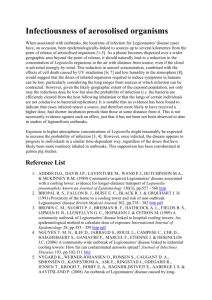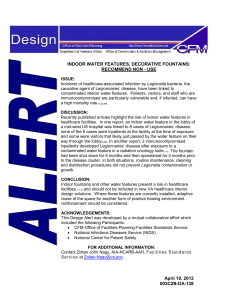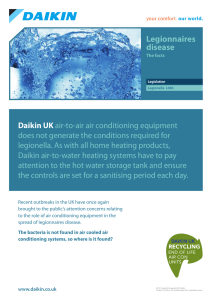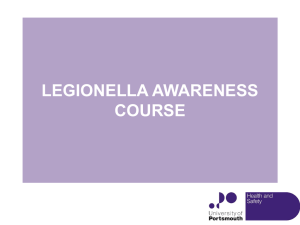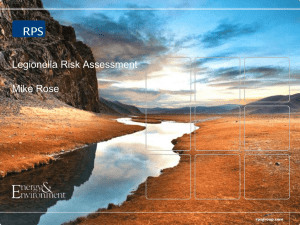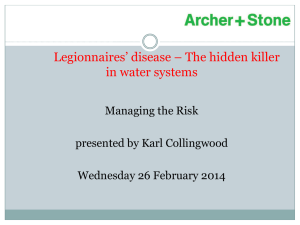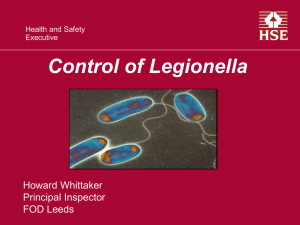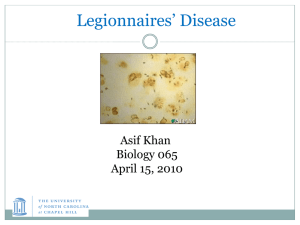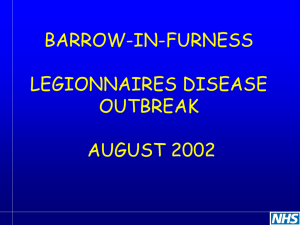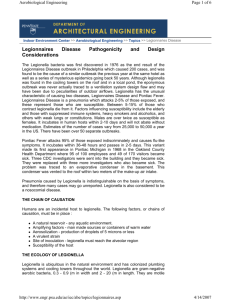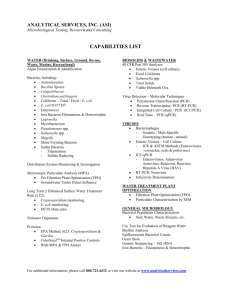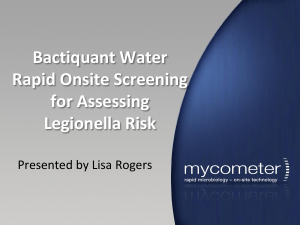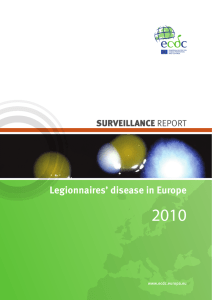Legionnaires Disease Information Sheet
advertisement
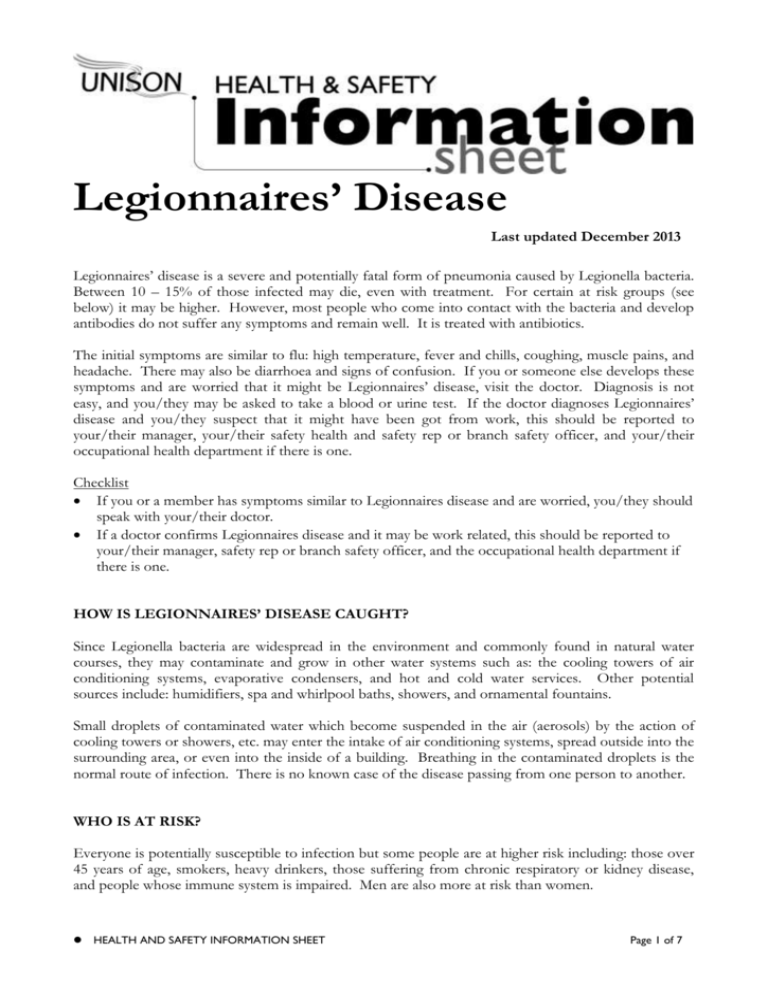
Legionnaires’ Disease Last updated December 2013 Legionnaires’ disease is a severe and potentially fatal form of pneumonia caused by Legionella bacteria. Between 10 – 15% of those infected may die, even with treatment. For certain at risk groups (see below) it may be higher. However, most people who come into contact with the bacteria and develop antibodies do not suffer any symptoms and remain well. It is treated with antibiotics. The initial symptoms are similar to flu: high temperature, fever and chills, coughing, muscle pains, and headache. There may also be diarrhoea and signs of confusion. If you or someone else develops these symptoms and are worried that it might be Legionnaires’ disease, visit the doctor. Diagnosis is not easy, and you/they may be asked to take a blood or urine test. If the doctor diagnoses Legionnaires’ disease and you/they suspect that it might have been got from work, this should be reported to your/their manager, your/their safety health and safety rep or branch safety officer, and your/their occupational health department if there is one. Checklist If you or a member has symptoms similar to Legionnaires disease and are worried, you/they should speak with your/their doctor. If a doctor confirms Legionnaires disease and it may be work related, this should be reported to your/their manager, safety rep or branch safety officer, and the occupational health department if there is one. HOW IS LEGIONNAIRES’ DISEASE CAUGHT? Since Legionella bacteria are widespread in the environment and commonly found in natural water courses, they may contaminate and grow in other water systems such as: the cooling towers of air conditioning systems, evaporative condensers, and hot and cold water services. Other potential sources include: humidifiers, spa and whirlpool baths, showers, and ornamental fountains. Small droplets of contaminated water which become suspended in the air (aerosols) by the action of cooling towers or showers, etc. may enter the intake of air conditioning systems, spread outside into the surrounding area, or even into the inside of a building. Breathing in the contaminated droplets is the normal route of infection. There is no known case of the disease passing from one person to another. WHO IS AT RISK? Everyone is potentially susceptible to infection but some people are at higher risk including: those over 45 years of age, smokers, heavy drinkers, those suffering from chronic respiratory or kidney disease, and people whose immune system is impaired. Men are also more at risk than women. HEALTH AND SAFETY INFORMATION SHEET Page 1 of 7 WHAT ARE AN EMPLOYERS DUTIES If there is a risk of contracting Legionnaires disease through their work, staff are covered by the Control of Substances Hazardous to Health Regulations (COSHH). These regulations, along with the Management of Health and Safety at Work Regulations require employers to risk assess the hazards that their work may expose employees and others to. The process of risk assessing Legionnaires disease is explained in further detail below. More detailed guidance on risk assessments in general, and COSHH and hazardous substances is are also available from UNISON. These will help UNISON safety reps to check whether their employers risk assessments are good enough. As usual with all risk assessments, any employees at risk must be given sufficient training and information about the risks and the necessary measures of prevention and control. Employers must also report any case of Legionnaires’ that may have been caught at work to the Health and Safety Executive (HSE), under the Reporting of Injuries, Diseases, and Dangerous Occurrences Regulations (RIDDOR). The duty to do this follows on from a doctor notifying the employer. Under the Notification of Cooling Towers and Evaporative Condensers Regulations, those who have control over premises with a cooling tower or evaporative condenser must notify the local authority in writing. They must also be advised if and when such devices are no longer in use. Notification forms are available from the local environmental health department. However, no notification is required if the water the equipment contains is not exposed to the air and the water and electricity supply are not connected. Employers (or persons in control of the workplace premises, such as landlords) are legally required to: identify and assess sources of risk from Legionnaires’; prepare a course of action ( a scheme – see below) for preventing or controlling any risk; implement, manage, and monitor the scheme (the precautions) - appointing a ‘responsible person’ (see below) to do such; keep records and check that what has been done is effective; and if appropriate, notify the local authority that they have a cooling tower on site. Assess the Risk Employers or someone else in control of premises (other duty holder) must risk assess for legionnaires and take appropriate measures to prevent or minimise the risk of exposure. If the employer or someone else in control of a building needs help and advice, this should first be sought from within their organisation but if this is not available, then from outside sources. Whoever conducts the risk assessment will need to be competent, which will include an understanding of water systems and associated equipment, such as pumps, heat exchangers, and showers. Are any of the water systems and equipment within the premises or on site likely to create a risk? There are foreseeable risks from: air conditioning systems with cooling systems with towers, evaporative condensers or dry/wet cooling systems; hot and cold water systems; humidifiers, spa and whirlpool baths, showers, and ornamental fountains; plus other and associated plant and systems. HEALTH AND SAFETY INFORMATION SHEET Page 2 of 7 The factors that make these systems a risk are: conditions that will encourage bacteria to multiply - for example, a water temperature (all or in part of the system) between 20 - 45°C; a source of food for the bacteria such as sludge, scale, rust, algae, or fouling; stored or re-circulated water; and/or the production or spread of water droplets - for example from showers or aerosols from cooling towers. A further risk factor is the exposure of particularly vulnerable people who may come into contact with the contaminated water droplets - see above in “Who Is At Risk” and bear in mind those in residential or nursing homes and healthcare settings. Once a potential source of risk has been identified (see above), the assessment must then: cover management responsibilities, name the “responsible person” (see below), and describe the water system; identify measures to prevent exposure or if not reasonably practicable to do this, then to control (minimise) the risk; include the details of monitoring or checks, inspections, and maintenance procedures and their results; and have a review date. If the assessment shows that there are no reasonably foreseeable risks or that they are insignificant and unlikely to increase, then the assessment is complete. No further action is necessary until either there is a change, there is reason to suspect the assessment is no longer valid, or it is time for a periodic review as few workplaces stay the same. So for example, further action will be necessary where: there is a change to or in the use of the plant (equipment), water system, or building; where there is new information about the risks or new control measures; where checks or routine testing indicates that the control measures may not be working effectively; or where there is a case of Legionnaires’. Prevention then Control If a risk is identified, an employer must first consider whether it can be avoided so far as is reasonably practicable by looking at the type of water system or method of work used. For example, is it possible to replace a wet cooling tower with a dry air-cooled system? If the risk cannot be prevented, controls must then be introduced. A written scheme must set out what will be done to control the risk from Legionella. It must describe: the entire water system - an up-to-date plan/schematic diagram and an asset register, who is responsible for carrying out the assessment and managing its implementation, the safe and correct operation of the water system (including for start-up or restarts, and shutdown procedures), what control methods and other precautions will be used (including details of chemical or physical (such as temperature) treatment programmes, cleaning and disinfection procedures), what and how often checks will be carried out on the controls scheme, checks of warning systems, maintenance requirements and frequencies, and operating cycles. and remedial action in the event of the scheme not being effective and emergency procedures. HEALTH AND SAFETY INFORMATION SHEET Page 3 of 7 The risks from exposure to Legionnaires’ will normally be controlled by measures which prevent or control the growth and multiplication of Legionella and then by minimising exposure to water droplets. The employer must: avoid water temperatures and conditions that encourage the growth of Legionella and other microorganisms (especially water temperatures between 20°C - 45°C, and a supply of nutrients such as rust, sludge, scale, algae, and other bacteria); avoid using materials that encourage the growth of Legionella – a unique reference directory of fittings, materials and appliances approved for their compliance with the UK plumbing regulations is available at: www.wras.co.uk/directory; ensure that water cannot stagnate anywhere in the system by keeping pipe lengths as short as possible, removing redundant pipework (dead legs), and regularly (at least weekly) flush through or use water systems including taps and showers; keep the system and the water in it clean and de-scale shower heads and hoses at least quarterly; treat the water to either kill Legionella (and other micro-organisms) or limit their ability to grow; ensure that the release of water spray is properly controlled; and ensure the correct and safe operation and maintenance of the water system. Responsible Person The 'responsible person' implements the control scheme and therefore needs to be competent – this means with sufficient knowledge, experience, instruction, and/or training on the system and the risks and sufficient authority to enable them to manage and control the scheme effectively. If there are several persons, for example because of shift-work patterns, everyone must know what they are responsible for and how they fit into the overall management of the system. If contractors carry out water treatment or other work, it is still up to the ‘responsible person’ (or employer or person in control of the premises) to ensure that the treatment is carried out to the required standards. Before employing a contractor, the employer or person in control of the premises must be satisfied that they can do the work to the required standard. It may be necessary, depending on the plant and the risks, to ensure that it is always possible to contact or call out a “responsible person” or their authorised deputy, with this information being available at access points to the equipment concerned. Record Keeping The usual requirements for risk assessments apply. If five or more people are employed, the employer must record the significant findings of the assessment and the details of any monitoring or checking carried out. However it is recognised as good practice by the HSE to record risk assessments even where there are less than five employees. There are several good reasons for an employer to do this including: a reminder of what they did and why, making any future review easier, and as evidence that they have complied with their duty to risk assess. Records of the written scheme and who is responsible for managing that scheme must also be kept. The records should include details of: the person or persons responsible for conducting the risk assessment, managing, and implementing the written scheme; the significant findings of the risk assessment, including precautionary measures and any groups of employees particularly at risk; the written control scheme and details of its implementation; and the results and dates of any inspection, test, or check carried out, including details of whether and how the system was operating, including stating if it was or was not in use. HEALTH AND SAFETY INFORMATION SHEET Page 4 of 7 All the above records must be kept for the period they cover and at least 2 years after. The results of monitoring, tests, checks, or inspections must be kept for a minimum of 5 years. WATER TREATMENT METHODS, ETC. It is important to maintain the cleanliness of the water system. The mechanisms and frequency for doing this will depend on the system, whether cleaning or disinfecting is being done routinely or as a result of a problem being identified during monitoring, and should be identified within the risk assessment. This should take account of factors such as whether the system is open or closed, the type and level of contamination, and the population that could be exposed. Cooling towers or evaporative condensers need measures in place to prevent or control the risk of Legionella, which may cause their own health hazards and so must be properly risk assessed prior to and when in use. In hot and cold water systems, Legionella is traditionally controlled by storing hot water above 60°C and distributing it at above 50°C, and keeping cold water below 20°C. The water may also be treated, but again this must also be risk assessed, including the risks of scalding where water runs hot with appropriate measures taken to prevent burns (such as warning notices and thermostatic mixing valves on taps). ‘Sentinel’ outlets (the furthest and closest tap, showers or other water outlets to each tank or cylinder) must be monthly checked for the distribution temperature of the waters. You should also check the hot water storage cylinder temperatures every month and cold water tank temperatures at least every six months. TESTING FOR LEGIONELLA Monitoring general bacterial levels, and sampling and testing for the presence of Legionella bacteria are ways of checking that the water system is under control. It is not simple and requires specialist help or training. Testing for Legionella bacteria is technically difficult, and a negative or positive result does not mean that none are present or that the control measures have failed. The testing of water samples in systems should be carried out by a suitably accredited company, at the recommended period or as determined by an appropriate risk assessment. Employers can get further details on sampling and testing in the HSE’s Legionnaires’ Disease Technical Guidance – see below. OTHER DUTIES Suppliers and producers of water systems and their components must ensure that such equipment is designed and implemented in a way so that it is safe to use at work and can be easily cleaned and maintained. They should tell purchasers/users what risks might be present and how to operate and maintain the system safely. They must tell the employer if, while they are treating the water system, they find any problems with it or the written scheme which could pose a significant risk of Legionella exposure. HEALTH AND SAFETY INFORMATION SHEET Page 5 of 7 BRANCH/SAFETY REP CHECKLIST Does the employer or other dutyholder: Give sufficient training and information to employees about any risks and the necessary measures of prevention and control. Know about Legionnaires’ disease, the risks, and those who are particularly vulnerable. Have a risk assessment which assesses any sources of risk from Legionnaires’, including – air conditioning systems with cooling systems with towers, evaporative condensers, or dry/wet cooling systems; hot and cold water systems; humidifiers, spa and whirlpool baths, showers, and ornamental fountains; other and associated plant and systems; conditions that will encourage bacteria to multiply - for example, a water temperature (all or in part of the system) between 20 - 45°C or a source of food such as sludge, scale, rust, algae, or fouling; stored or re-circulated water; the production or spread of water droplets - for example from showers or aerosols from cooling towers. Have in place appropriate measures for the prevention or control of any risk which in the first instance should be avoided (prevention) so far as is reasonably practicable by looking at the type of water system or method of work used. For example, is it possible to replace a wet cooling tower with a dry air-cooled system? And... if the risks cannot be prevented, then a written scheme must set out what will be done to control the risks, and must describe: the entire water system (with an up-to-date plan/schematic diagram and an asset register), who is responsible for carrying out the assessment and managing its implementation, the safe and correct operation of the water system (including start-up or restarts, and shutdown procedures), what control methods and other precautions will be used (see below), what and how often checks will be carried out on the controls, the checks of warning systems, maintenance requirements and frequencies, operating cycles, remedial action in the event of the scheme not being effective, and emergency procedures. control measures include avoiding water temperatures and conditions that encourage the growth of Legionella and other micro-organisms (especially temperatures 20°C - 45°C, and a supply of nutrients such as rust, sludge, scale, algae, and other bacteria); avoiding the using of materials that encourage the growth of Legionella – the materials should comply with the UK plumbing regulations (see above); ensuring that water cannot stagnate anywhere in the system by keeping pipe lengths as short as possible, removing redundant pipework, and regularly (at least weekly) flushing through or using water systems; keeping the system and the water in it clean and de-scaled; treat the water to either kill Legionella (and other micro-organisms) or limit their ability to grow; HEALTH AND SAFETY INFORMATION SHEET Page 6 of 7 ensure that the release of water spray is properly controlled; and ensure the correct and safe operation and maintenance of the water system. Have a “responsible person” appointed with sufficient authority and competence (that is with sufficient knowledge, experience, instruction, and/or training on the water systems and the risks) to effectively implement, manage, and monitor the scheme. Ensure that any contractors are also competent to work on the water system. Keep records of the risk assessments and the control scheme including – the person or persons responsible for conducting the risk assessment, managing, and implementing the written scheme; the significant findings of the risk assessment, including precautionary measures and any groups of employees particularly at risk; the written control scheme and details of its implementation; and the results and dates of any inspection, test, or check carried out, including details of whether and how the system was operating, including stating if it was or was not in use. Keep the risk assessment and written scheme under review periodically, and also where there has been a change or reason to suspect that the assessment, controls, or scheme are no-longer valid (see above). Consult with the safety reps on the risk assessment including measures of prevention and control, the appointment of the “responsible person”, and the information and training for employees. Inform the safety reps, the members, and the HSE if Legionella bacteria are found in the workplace or if a case of workplace Legionnaires’ is suspected. Members/Employees: If you/they have symptoms similar to Legionnaires disease and are worried, you/they should speak with your/their doctor. If a doctor confirms Legionnaires disease and it may be work related, this should be reported to your/their manager, safety rep or branch safety officer, and the occupational health department if there is one. FURTHER INFORMATION AND ADVICE Legionnaires’ disease, A brief guide for dutyholders - www.hse.gov.uk/pubns/indg458.pdf. Legionnaires’ Disease: the Control of Legionella Bacteria in Water Systems, Approved Code of Practice and Guidance on Regulations - ISBN 9780717666157, L8 (fourth edition). Priced £8.00 from the HSE for hardcopy, or free to download here: www.hse.gov.uk/pubns/priced/l8.pdf. Gives detailed guidance on the employers or other dutyholders legal duties. Legionnaires' Disease - Technical Guidance - www.hse.gov.uk/pubns/books/hsg274.htm. Gives employers or other dutyholders detailed HSE guidance on the technical issues and specifications of preventing and controlling legionnella risks for various water systems and plant (equipment). Health and safety in care homes, HSG220 - www.hse.gov.uk/pubns/priced/hsg220.pdf. Provides guidance on how to manage the risks at care homes. HEALTH AND SAFETY INFORMATION SHEET Page 7 of 7
